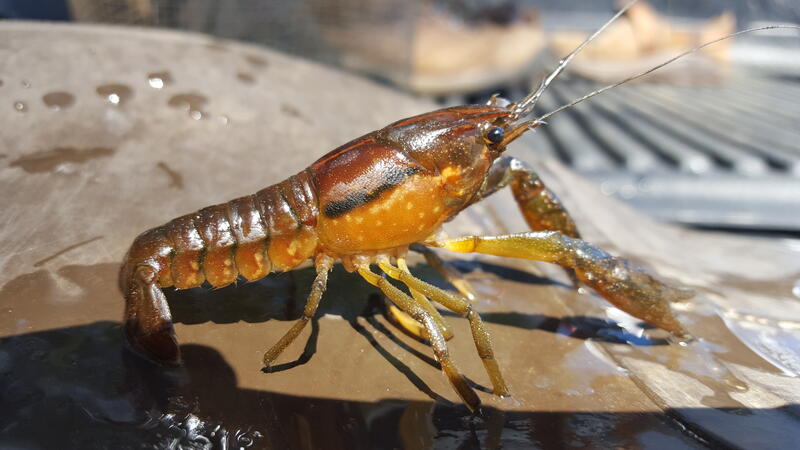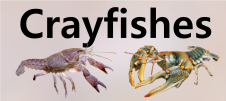







Loading profile. Please wait . . .
Procambarus lunzi (Hobbs, 1940)
Hummock Crayfish




Federal Protection: No US federal protection
State Protection: No Georgia state protection
Global Rank: G4
State Rank: S3S4
Element Locations Tracked in Biotics: No
SWAP 2015 Species of Greatest Conservation Need (SGCN): No
SWAP 2025 Species of Greatest Conservation Need (SGCN): No
2025 SGCN Priority Tier: None
Element Occurrences (EOs) in Georgia: 0
Habitat Summary for element in Georgia: Associated with vegetation in ponds, ditches, swamps, and streams; also found in simple burrows
The carapace of the Hummock Crayfish is reddish-brownish dorsally with light and dark irregular splotches. There is a pale central stripe on the carapace and a dark (blackish) stripe on each side; the saddle at rear of carapace is poorly developed or nonexistent. Below the stripes on the sides, the carapace has a brownish-pinkish hue with light irregular splotches. The abdomen has a wide dark or reddish dorsal stripe and darker thin stripes on the lower sides. The claws are brownish with dark splotches and dark tubercles. The areola is fairly narrow but never obliterated. The rostrum is long, tapering, and usually has marginal spines or tubercles. A single, small cervical spine or tubercle is usually present (Hobbs 1981). This species reaches a maximum total body length of about 74 mm (2.9 in).
The Hummock Crayfish has been collected with several other members of the genus Procambarus including many of its close relatives in the same subgenus. Differs from Eastern Red Swamp Crawfish (P. troglodytes) by having dark tubercles on the claws rather than reddish-orangish tubercles. Differs from Blackwater Crayfish (P. litosternum) and Seminole Crayfish (P. seminolae) by having a dark longitudinal stripe on either side of the carapace rather than two discrete spots on either side. Differs from Black Mottled Crayfish (P. enoplosternum) and Humpback Crayfish (P. epicyrtus) by lacking obvious dark saddle at rear of carapace.
Hummock Crayfish lives in a wide variety of habitats including ponds, ditches, swamps, and sluggish areas of streams. In areas where the water is present only part of the year, it is often found in simple burrows (Hobbs 1981).
No studies of the Hummock Crayfish are known. Crayfishes are considered opportunistic omnivores and likely feed on live and decaying vegetation, aquatic insect larvae, small fishes, and dead animal matter.
Crayfishes that inhabit open water typically hide during the day and come out at night to feed. Reproduction usually occurs during the spring and fall, but males in reproductive condition may be found at any time during the year. When female crayfish are ready to lay eggs, they usually find a secure hiding place and hence are rarely encountered. When the eggs are released, the female attaches them to her swimmerets and is said to be “in berry.” Upon hatching, the juvenile crayfish are attached to the mother by a thread. After the juveniles molt for the second time, they are free of the mother, but stay close and will hold on to her for some time. Eventually they move off on their own. Crayfishes molt 6 or 7 times during their first year of life and most are probably able to reproduce by the end of that year. Including data from Georgia and South Carolina, male Hummock Crayfish in reproductive condition have been collected in every month of the year except March, July, and October. A single female with eggs was collected from a burrow in August and another in September. Several females with eggs and young attached were found in a thickly vegetated pond on Sapelo Island in September. The smallest breeding male known is about 52 mm (2 in) and the only Georgia female carrying eggs that was measured is about 53 mm (2.1 in) in length (Hobbs 1981; Skelton unpubl. data).
Since this species is found in a variety of habitats, using a seine or dipnet in streams, ponds, ditches, and other slackwater habitats can yield the species. Excavating burrows adjacent to temporary habitats or stream margins may also produce this species.
The Hummock Crayfish ranges from the North Fork Edisto River in South Carolina, south to the South Carolina coast, to just south of the Altamaha River drainage in Georgia (Eversole and Jones 2004; Hobbs 1981).
This species is threatened in Georgia by land uses within its range that could alter hydrology and water quality. Introduction of non-native species is a threat to all native crayfishes.
This species is common and widespread in Georgia and is thus considered secure.
General watershed level protection measures will help secure the continued existence of the Hummock Crayfish in Georgia. These include the protection of riparian zones, control of sediment and nutrient runoff from farms and construction sites, and limiting the amount of impervious cover (e.g., pavement) within occupied watersheds. Non-native crayfishes should never be used for bait. Instead, anglers should use crayfishes collected from the river system they will be fishing in and should never release unused bait crayfish back into Georgia waters.
Eversole, A.G. and D.R. Jones. 2004. Key to the crayfish of South Carolina. Clemson University, Clemson, SC. 43 pp.
Hobbs, H.H., Jr. 1981. The crayfishes of Georgia. Smithsonian Contributions to Zoology 318:1–549.
Taylor, C.A., G.A. Schuster, J.E. Cooper, R.J. DiStefano, A.G. Eversole, P. Hamr, H.H. Hobbs III, H.W. Robison, C.E. Skelton, and R.F. Thoma. 2007. A reassessment of the conservation status of crayfishes of the United States and Canada after 10+ years of increased awareness. Fisheries 32:372–389.
Christopher E. Skelton
C. Skelton, August 2012: original account
C. Skelton, March 2019: general update of account.
D.Weiler, October 2019: photo added